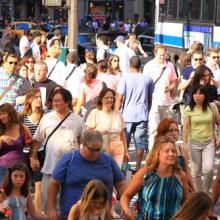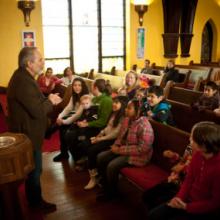From Times Square to Timbuktu
The story of world Christianity’s recent pilgrimage is dramatic and historically unprecedented. The “center of gravity” of Christianity’s presence in the world rested comfortably in Europe for centuries. In 1500, 95 percent of all Christians were in that region, and four centuries later, in 1910, 80 percent of all Christians were in Europe or North America.
But then, world Christianity began the most dramatic geographical shift in its history, moving rapidly toward the global South, and then also toward the East. By 1980, for the first time in 1,000 years, more Christians were found in the global South than the North. Growth in Africa was and remains incredible, with one of our four Christians now an African, and moving toward 40 percent of world Christianity by 2025. Asia’s Christian population, now at 350 million, will grow to 460 million by that same time. Even today, it’s estimated that more Christians worship on any given Sunday in churches in China than in the U.S.
In the age of the internet, we have access to a vast quantity of information beyond our dreams even twenty years ago. Most of the time, I use this power to look at LOLCats and Buzzfeed articles like "11 Signs You Might be Dating a Pirate."
But as a Christian who feels the weight of caring for the people Jesus called "the least of these," I feel a responsibility to be educated about the plight of the billions of people who live on less than $2 per day around the world (and here in the US, as recently evidenced by the cuts to food stamp programs).
Caring for the poor directly in our neighborhoods is essential to the mission of the local church, and universally, it is the Church’s responsibility to care for the poor in every corner of the planet.
A global leader in ecumenical movement has alerted participants to the forthcoming World Council of Churches 10th Assembly in Busan, to be aware that they meet in rapidly changing times for world Christianity.
He says there are consequences for all church institutions, including the WCC itself.
Rev. Wesley Granberg-Michaelson, in a book timed to coincide with the gathering, says so fundamental are the changes now shaping the Christian world that the WCC will need to "commit to deep change."
It they don't, he says, they could remain largely isolated from the dynamic and growing parts of the church, especially from the global South.
His perceptions are likely to strike a chord at when the World Council of Churches meets in Busan from Oct.30 to Nov. 8 for its 10th Assembly, the highest decision making body of the grouping that represents some 560 million Christians.
Granberg-Michaelson, is a former member of the main governing body of the WCC, its central committee, and worked on the staff of the organization for six years, originally as director of the Church and Society programme.
He says the book, From Times Square to Timbuktu, is an attempt to describe the "growing gulf" occurring in world Christianity, primarily between the burgeoning Pentecostal and evangelical churches in the global South and the declining churches of the global North.
As Congress makes a final attempt this fall to act on comprehensive immigration reform, the debate is focusing on “securing” our borders and offering a path to citizenship to the 11 million residents here without proper documentation. These politicized arguments, however, don’t see the forest for the trees.
We’re not viewing the broader impact that immigration has had on American society, especially since the last major immigration reform of the 1960s. In particular, we’re missing the way immigration is transforming the religious life of North America.
We commonly view immigration as introducing large numbers of non-Christian religions into U.S. society. True, because of immigration in the last half century, America has become the most religiously diverse country in the world, with thousands of mosques and temples dotting our religious landscape.



